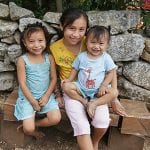Social Interaction and Social Learning: A Cross-Cultural Comparative Study
Do children learn equally from overheard interactions and direct interactions?
Is directed communication a universal feature of all early learning environments or is it specific to certain communities?

Laura Shneidman
Postdoctoral Researcher
 We are exploring the presence of child directed communication, and its role in information early learning for children from two cultural communities: A Yucatec Mayan community in Southeastern Mexico, where past research has shown that children have many opportunities to observe others, and a U.S. community, where children may regularly experience directed interactions with caregivers. We are investigating the contexts under which children learn actions form other people. Children will learn about some new toys from either someone directly teaching them or they will observe other people acting on these toys. We are also exploring how children effectively learn words from others where we will show children some new objects and label them either while directly addressing the child or addressing another individual.
We are exploring the presence of child directed communication, and its role in information early learning for children from two cultural communities: A Yucatec Mayan community in Southeastern Mexico, where past research has shown that children have many opportunities to observe others, and a U.S. community, where children may regularly experience directed interactions with caregivers. We are investigating the contexts under which children learn actions form other people. Children will learn about some new toys from either someone directly teaching them or they will observe other people acting on these toys. We are also exploring how children effectively learn words from others where we will show children some new objects and label them either while directly addressing the child or addressing another individual.
Publications
- Shneidman, L., Todd, R. & Woodward, A.L. (in press). Why do child-directed interactions support imitative learning in young children. PlosOne.
- Shneidman, L., Sootsman-Buresh, J., Shimpi, P., Knight-Schwartz, J., & Woodward, A.L. (2009). Social experience, social attention, and word learning in an overhearing paradigm. Language Learning and Development. 5, 4, 266-281.
- Shneidman, L. A. and Goldin-Meadow, S. (2012), Language input and acquisition in a Mayan village: how important is directed speech?. Developmental Science, 15: 659–673.